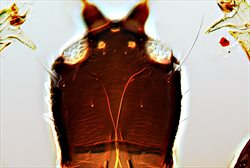
Head of female microptera
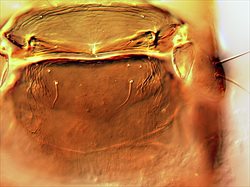
Meso & metanota
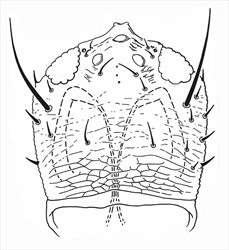
Head of female microptera

Antenna
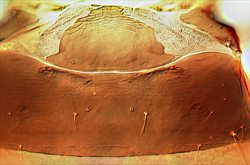
Pelta & tergite II

Pelta & tergite II
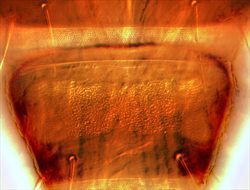
Male sternite VIII
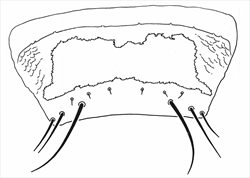
Male sternite VIII
Both sexes with wings shorter than thorax width, females also fully winged. Body and femora brown, tarsi yellow, tibiae all brownish yellow; antennal segment III brownish yellow, IV–VI variably yellow at base but not sharply bicoloured; fore wings weakly shaded toward apex. Antennae 8-segmented; segment III with 3 short, straight sense cones (micropterae sometimes with 2), IV with 4 sense cones; VIII constricted to base. Head longer than wide, cheeks swollen behind small forwardly directed eyes in micropterae; cheeks constricted to base, with several small, slender setae; postocular setae very long and pointed, wide apart; maxillary stylets retracted to eyes, close together medially. Pronotum without sculpture medially, with 4 pairs of very long, slender pointed major setae, anteromarginals scarcely larger than discal setae; prosternal basantra absent. Fore tarsal tooth large in both sexes. Metanotum without sculpture medially. Fore wing parallel sided, with about 10 duplicated cilia. Abdominal tergite I, the pelta, with lateral margins confluent with anterior margin of tergite II; tergites II–VII with two pairs of sigmoid wing-retaining setae, marginal setae S1 long and pointed; tergite IX setae S1 pointed, at least 0.8 as long as tube.
Males varying in size, large males with fore femora swollen; tergite IX setae S2 short and stout; sternite VIII with large pore plate but scarcely extending posterior to spiracles, median longitudinal length of pore plate 50–60 microns.
The genus Hoplothrips includes about 120 named species, but there are no modern identification keys to any substantial number of species. The most common species are known to exist as both winged and wingless morphs. Moreover, these species exhibit considerable sexual dimorphism, and males of the same species vary in body size, with some structures exhibiting patterns of allometric growth. As a result, species identification is often difficult (Mound & Walker, 1986; Kobro & Rafoss, 2006; Okajima, 2006). Hoplothrips corticis is similar to H. ulmi, with short, straight, antennal sense cones, but the tibiae and antennal segments are less sharply bicoloured, the pelta lateral margins are confluent with the anterior margin of tergite II, and the transverse pore plate on sternite VIII of males is much larger.
Breeding on or under the bark of dead branches, also the trunks of dead Quercus [Fagaceae], Populus [Salicaceae] and Tilia [Tiliaceae] trees, and presumably feeding on fungal hyphae.
Recorded relatively infrequently in Britain, but with records widely distributed in southern England, and again in northern Scotland (Mound et al., 1976). Widespread in northern and central Europe and extending into North America and Japan; introduced into New Zealand.
PHLAEOTHRIPIDAE - PHLAEOTHRIPINAE
Hoplothrips corticis (De Geer)
Thrips corticis De Geer, 1773: 11
Trichothrips copiosa Uzel, 1895: 252
Trichothrips aceris Karny, 1913: 125
Kobro S & Rafoss T (2006) Identification of adult males and females of Hoplothrips species (Thysanoptera: Tubulifera) known from Norway, and some deductions on their life history. Entomologica Fennica 17: 184–192.
Mound LA, Morison GD, Pitkin BR & Palmer JM (1976) Thysanoptera. Handbooks for the Identification of British Insects 1 (11): 1–79.
Mound LA & Walker AK (1986) Tubulifera (Insecta: Thysanoptera). Fauna of New Zealand 10: 1–140.
Okajima S (2006) The Suborder Tubulifera (Thysanoptera). The Insects of Japan 2: 1–720.